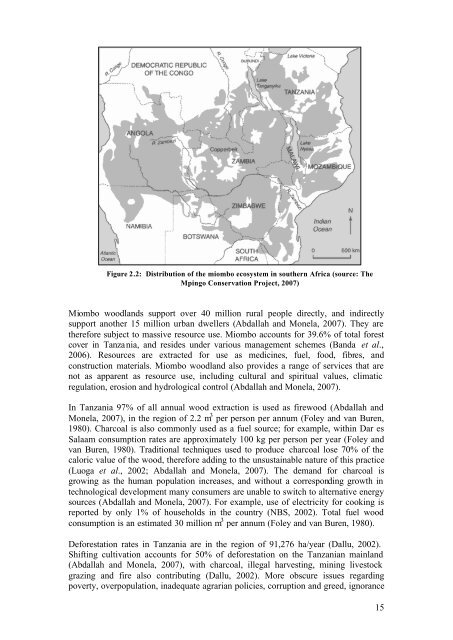Figure 2.2: Distribution of the miombo ecosystem in southern Africa (source: TheMpingo Conservation Project, 2007)Miombo woodlands support over 40 million rural people directly, and indirectlysupport another 15 million urban dwellers (Abdallah and Monela, 2007). They aretherefore subject to massive resource use. Miombo accounts for 39.6% of total forestcover in <strong>Tanzania</strong>, and resides under various management schemes (Banda et al.,2006). Resources are extracted for use as medicines, fuel, food, fibres, andconstruction materials. Miombo woodland also provides a range of services that arenot as apparent as resource use, including cultural and spiritual values, climaticregulation, erosion and hydrological control (Abdallah and Monela, 2007).In <strong>Tanzania</strong> 97% of all annual wood extraction is used as firewood (Abdallah andMonela, 2007), in the region of 2.2 m 3 per person per annum (Foley and van Buren,1980). Charcoal is also commonly used as a fuel source; for example, within Dar esSalaam consumption rates are approximately 100 kg per person per year (Foley andvan Buren, 1980). Traditional techniques used to produce charcoal lose 70% of thecaloric value of the wood, therefore adding to the unsustainable nature of this practice(Luoga et al., 2002; Abdallah and Monela, 2007). The demand for charcoal isgrowing as the human population increases, and without a corresponding growth intechnological development many consumers are unable to switch to alternative energysources (Abdallah and Monela, 2007). For example, use of electricity for cooking isreported by only 1% of households in the country (NBS, 2002). Total fuel woodconsumption is an estimated 30 million m 3 per annum (Foley and van Buren, 1980).Deforestation rates in <strong>Tanzania</strong> are in the region of 91,276 ha/year (Dallu, 2002).Shifting cultivation accounts for 50% of deforestation on the <strong>Tanzania</strong>n mainland(Abdallah and Monela, 2007), with charcoal, illegal harvesting, mining livestockgrazing and fire also contributing (Dallu, 2002). More obscure issues regardingpoverty, overpopulation, inadequate agrarian policies, corruption and greed, ignorance15
and carelessness, under-evaluation of natural forests and open access to general areasalso affect deforestation rates (Abdallah and Monela, 2007). For example, studies inMalawi and Mozambique have shown that the prevalence of HIV/AIDS is having alarge impact on the utilisation of miombo woodland resources, a trend that requiresmanagement plans to take into consideration the increasing HIV/AIDS pandemicthroughout southern Africa (FAO, 2007). As the ability of affected households tocultivate their land diminishes, they tend to rely increasingly on gathering fromwoodlands for their daily subsistence needs, income and natural medicines. Areaswith higher HIV/AIDS prevalence were shown to be experiencing a more rapiddecline in woodland quality and availability than those with lower rates (FAO, 2007).The degree to which HIV/AIDS impacted on the resource use was very dependent ona range of socio-economic factors particular to those villages concerned. Thisdemonstrates that adjustment of forestry management plans in response to thesefindings will need full participation on a very local basis from people actuallyexperiencing the demand for natural resources as a result of HIV/AIDS (FAO, 2007).In conjunction with the extra pressures placed upon miombo from the growingprevalence of HIV/AIDS, there are additional potential problems resulting fromincreasingly erratic weather patterns. Reduction in rainfall quantities andpredictability may lead to crop failure and food shortages, forcing rural people to turnever more to miombo products for sustenance (Abdallah and Monela, 2007). Thesecomplex socio-economic problems need to be fully understood before adequatesolutions to deforestation and degradation can be produced (Abdallah and Monela,2007).Results of degradation can be far reaching, from loss of soil quality creating fooddeficiencies to inadequate water supplies. Within <strong>Tanzania</strong> much of miombowoodland is held under general lands, which lack any management institution, andtherefore they are rapidly being lost to deforestation (Abdallah and Monela, 2007).Logging in public lands within <strong>Tanzania</strong> is in the region of 6.38 m 3 ha- 1 per year,vastly exceeding the mean annual increment (MAI) of 4.35 m 3 ha- 1 (Luoga et al.,2002) and is highly unsustainable. The intensity with which an area is utilised isdependent upon its proximity to roads and settlements, previous use patterns andaccessibility. Miombo woodlands are in a state of rapid change (Baékus et al., 2006)and effective management plans are required urgently to safeguard their future.2.7 Future of the ValleyThe Kilombero Valley holds some of the most fertile lands and rich fisheries of<strong>Tanzania</strong>. However, internal population growth and the influx of people fromdifferent areas has created an increased demand for food, and therefore the use ofwetland resources has increased and intensified over the past few decades (Kangalaweand Liwenga, 2005). The increase in both subsistence farming and the continuedexpansion of commercial agriculture ventures is threatening the continued stability ofthe ecosystem through deforestation and soil degradation due to increased clearanceof land for agriculture and increasing livestock numbers. This is leading to a conflictof interest between environmental conservation and the livelihoods of localcommunities, and resource use conflict between different users will increase in thefuture (Kangalawe and Liwenga, 2005). This is already being experienced within theKilombero Valley as the increasing numbers of pastoral herds-people and their cattle16
















